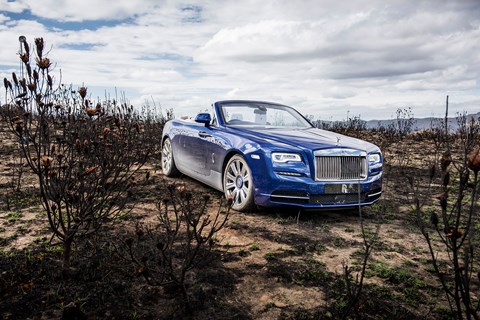► The big drive: new Rolls-Royce Dawn across Africa
► We tackle its deserts, its mountain passes and ocean roads
► New convertible Dawn on sale now for £264,000
Drunk is the best way to experience the new Rolls-Royce Dawn. Not completely legless, obviously: you still need to be able to drive the thing. I mean the kind of drunk you get when you share two bottles of wine between three people over an ostrich steak dinner. The kind of drunk that makes everything seem funnier and your legs move a bit faster.
When you’re this kind of drunk, when you stop thinking about how it’s done and are more open to how it feels, the Dawn’s extraordinary mechanical refinement is eerie. Ahead of you, an up-lit Spirit of Ecstasy leads the way across the dark desert floor. The air springs float over the rough gravel track. Barely breaking walking pace, you can’t hear the engine over the chirping of the cicadas, even with the roof down. You kick off your shoes and dig your left foot down into the inch-thick lambswool rug, and over your head Rolls-Royce’s famous ‘starlight’ headliner has been replaced by the real Southern Cross.
I feel some explanation is required if this opening paragraph is to make it past the editor and not fill the letters page for the next three issues. Believe me, I am a doctrinaire non-drink-driver, and I don’t think CAR’s readership is impressionable enough to try to emulate this episode in the Dawn, although nothing teaches you not to drink-drive like drinking and driving.
And the situation was unrepeatable. After a long day’s driving we’d arrived late at one of the ‘feather palaces’ in South Africa’s Klein Karoo desert. These exuberant homes were built by the ostrich barons who grew fabulously and unpredictably wealthy when the 19th century craze for ostrich feathers for ladies’ hats briefly made this odd crop more valuable than gold. The parched, scrubby landscape can’t grow anything capable of supporting these extravagances now, but a few have become guest houses. Ours has been in the same family for five generations. They didn’t bat an eyelid when we arrived in an electric-blue convertible Roller with no number plates: they just served us a Michelin-standard dinner, each of the five courses (and the wine) presented by the farmer with hands like shovels.
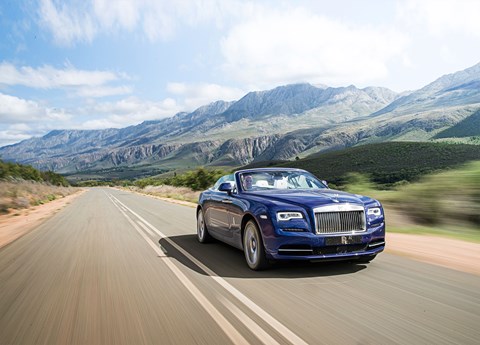
I have never eaten a better meal in an odder or more remote location. It was only once we’d finished that we realised we weren’t staying in the main palace but had been given our own bungalow in glorious isolation on the far side of the farm, a couple of kilometres away over a desert track. There are puff adders in that desert, so walking wasn’t an option. Nor was leaving our £300,000 car out of sight. The track was private and there was nothing to hit: the greatest risk was spilling the half-finished bottle of pinotage the farmer insisted we take with us over the priceless white (yes, white) leather of the Dawn. My companions were fully consenting and very enthusiastic about the idea (can’t think why) so I broke the habit of a lifetime. I’d come all this way to do something unusual in a Rolls-Royce, after all, and I’ll definitely never do this again. I know of one A-list rock star who used to get stoned and drive his Rolls around a field to better appreciate its serene ride quality. I now see why.
If you occasionally look at inferior motoring media you’ll know that Rolls-Royce presented the new Dawn to the world’s press in South Africa’s Western Cape. If you have to launch a convertible in March it’s wiser to do it in the southern hemisphere than on the south coast of England, where the Dawn is made. The other media were shepherded on a gentle tour of Cape Town and the winelands but CAR, being awkward, wanted to do something different.
South Africa is – with caveats – a great place to drive. The roads are good, and the attitude to speeding relaxed. I’ve long thought that you can do a better and more varied day’s driving here than almost anywhere else in the world: starting (at dawn, if you like) on an ocean road, then heading inland and over as many near-Alpine passes as you have time for before heading further into the country’s often-overlooked Karoo hinterland, only stopping when you reach real African desert. Ocean, mountain and desert in a day, in a Dawn.
Other than looking spectacular, a trip like this might serve a couple of other purposes too. The first is to reconnect with Rolls-Royce as a maker of cars, and not just luxury goods. Yes, almost every car that comes out of Goodwood is a visually unique bespoke creation by its owner. But these cars are more than just paint and wood and leather. They have oily bits too, including a 6.6-litre twin-turbocharged V12 engine making 563bhp and capable of launching you, your mistress and her stupid lap-dog to 60mph in less than five seconds. The Dawn ought to be capable of epic road trips, even if it will seldom be used this way. Rolls-Royce’s new Black Badge ‘performance’ line and the Cullinan ‘high-riding vehicle’ will start to shift our perception of the brand back to the car and the journey. I thought I’d get started early.
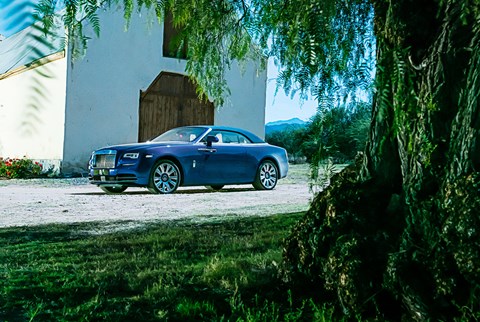
And I liked the idea of experiencing a Rolls-Royce the way an owner in the 1920s might have done: when road surfaces and fuel supplies weren’t as reliable as they are now in Mayfair or St. Tropez, when drivers still chose a Rolls-Royce for its strength as much as its luxury, and when seeing one drive through your town or village was as incongruous and exciting as a low pass by a fast jet is today.
Fine, said Rolls-Royce. Take the car. But please, stay out of the townships. And meet Zaphon. Zaphon is the former South African kick-boxing champion and he and the Glock 17 tucked in his waistband will be accompanying you on your trip; either following close behind with a driver in a black BMW X5, or if he thinks it necessary, in the car with you.
This is the first and doubtless only time I will have an armed bodyguard. Only in South Africa has a carmaker felt the need to provide one along with the car. The country’s crime rate and continuing colossal inequality are beyond the remit of a car magazine, but the gap between the Dawn’s list price and the ability of the typical bystander to afford it is greater even than South Africa’s $7000 average household income suggests. People (mostly) smile and wave and take photos, but you never forget that you’re driving something that might look offensively self-indulgent to some.
Not a problem, however, at the Delaire Graff wine estate near Stellenbosch, owned by the Graff diamond dynasty and Rolls-Royce’s base for the launch. Our car is parked outside the main lodge and looks gaspingly good in its bright Salamanca blue paint, Arctic White leather and swathes of boldly striped macassar-wood veneer that cover the rear deck and plunge down into the cabin. This is, Rolls insists, more than just a Wraith with the roof cut off: four-fifths of the body panels are new. I believe them. Rolls-Royce won’t care, but I’ve never really got on with the Wraith’s slightly awkward proportions and surfacing. The Dawn just seems instantly, obviously right. It promises to be good to drive too: it weighs a monstrous two and a half tonnes but the benefit is a super-rigid body, according to its maker. The hallmark suicide doors help, allowing the A-pillar and scuttle to be optimised for stiffness.
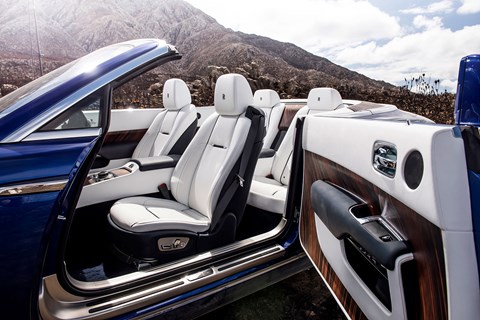
Ah yes, those doors. I’ve been lucky enough to drive a few Rolls-Royces equipped with them, but being very stupid I can never overcome the lifelong habit of turning back slightly as I get out, as you do with a normal door. I did it again the first time I exited the Dawn, smashing my nose so hard into the side glass that was unexpectedly now behind me that I had to check for a nosebleed. Nobody watching could have been under any illusion that I owned the car.
For our coastal road I’d picked the R44 that looks back towards Cape Town across False Bay, and past the Cape of Good Hope to the Indian Ocean. You’ve seen this road before: it has been used for countless car ads and photo shoots and with good reason; it is heart-stoppingly beautiful. Big, Irish-looking mountains bathed in soft sunlight tumble down to the sea and the road follows their forms a hundred feet or so above the water. The curves are gentle and the road surface fine and with the intense scent of the cypresses (the African variety) you could be on one of the Mediterranean coast roads this car was designed for.
I wasn’t taking the car out of its comfort zone, yet, but I did get a sense of how fit it is for its real purpose. The open roof is about more than the sun on your neck and the wind in your hair. In a closed-roof car you just wouldn’t feel part of this extraordinary scenery, as you do in the Dawn; especially from the rear seats, which really do take an adult in comfort. That’s the way to go; sitting back there with little to interrupt your view. This is the Rolls-Royce least likely to be driven by a chauffeur, but it wouldn’t be a bad idea.
Next, the mountains. The ranges that separate Cape Town and the coast from the Karoo desert are crossed by a series of passes which can’t quite match those in the Alps for length or altitude, but do offer big views and ribbony series of hairpins. I headed for the Franschhoek Pass, which climbs from the pretty little wine-producing town of the same name up to a gap in the mountains. These look Irish too, and so does the weather now: the top is shrouded in cloud and has only just lifted by the time we get up there, and I reckon the big Cape gales were blowing at force seven or eight. Some of the roadside crosses are for motorcyclists who have been blown off their bikes and over the edge. The wildlife is far from Irish though: troupes of baboons on the lower reaches, giving way to leopard at the top. Best get the pictures done quickly.
These are roads for a 911, not a two-and-a-half-tonne, four-seat open-top Rolls-Royce. But the same chassis stiffness that allows the air suspension to do its job and deliver that famed magic-carpet ride on the coast road also means the Dawn doesn’t fall apart when given the hurry-up up here. The steering is fingertip-light and low-geared, but consistent and precise. More importantly there’s none of the weird twisting across the scuttle that you could maybe forgive this car for. It’s odd that Rolls-Royce should be so genuinely, hand-wringingly nervous about introducing the Black Badge performance line (just don’t call it ‘sporty’). A little more steering weight and body control would be absolutely right on these roads. The cars deserve it and Rolls-Royce’s new and terrifyingly young breed of buyers demand it, and the dukes who might once have objected are all dead.
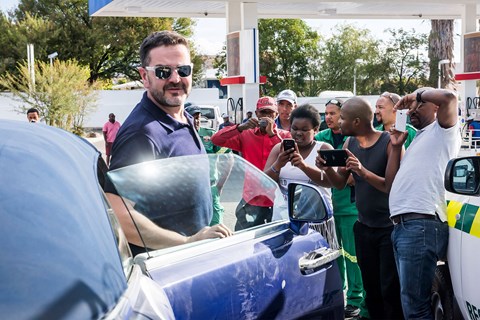
Coming down from the Franschhoek Pass the scenery changes again, and more dramatically. There are weird rocky moonscapes stubbled with clumps of protea, South Africa’s robust national flower, blackened by wildfires, and stretches of sand punctured by scorched tree trunks, their branches all burnt off. As you head for the Karoo desert the roads are straight and traffic-free and you can start to stretch that V12 a little, although even at 100mph its power reserve gauge is showing that there’s still another 80% to come.
Once into three figures you might want to raise the roof too, and examine Rolls’s claim that the six-layer hood makes the Dawn the world’s quietest convertible inside with the roof up. It’s like being in a Wraith, and gives me the chance to have a proper conversation with the slightly terrifying but doubtless effective Zaphon. ‘When I was younger, before I discovered kick-boxing, I had a really short temper. I was more of a brawl kind of guy.’
The conversation is interrupted by our only police stop of the trip, by a young officer in a tasteful unmarked white Golf GTI. ‘Uh, my senior officer said there was a blue Rolls-Royce with no number plates doing a high speed and that I should stop you,’ he explains, apologetically. I can’t deny any of the allegations but I explain who we are and why we have the car, and Zaphon whispers something in the policeman’s ear. I didn’t ask what he said, but it works. The cop apologises again, asks if he can take a picture of the car, tells us there’s a speed trap further down the road and lets us go.
Finally, after 500km we see a sign for the Rietsfontein Ostrich Palace at the side of our dark desert highway, and stop for the night. Thinking we were done with driving we thought we deserved that drink. The Dawn had seen ocean, mountain and desert in a day, and despite racking up value-altering mileage we’d still only seen a tiny corner of this country.
But it turned out we would see a bit more of it, and not just the two kilometres across the farm to our beds. When we woke the next morning the vast red hulk of the Swartberg mountains was looming over the bungalow. The Swartberg Pass crosses it. It’s one of the country’s highest and most dramatic, but I hadn’t included it in the route because it’s a single rough gravel track for most of its 50km. But it is passable in a road car, and the Dawn hadn’t really felt challenged yet, and had proved so comfortable over the rough gravel farm track the night before. And Rolls-Royces have crossed terrain like this since their earliest days, in the pre-war Alpine trials or in the service of Lawrence of Arabia. So with a silent apology to the good folks at Goodwood who wore out their elbows buffing that paintwork, we took the long way back.
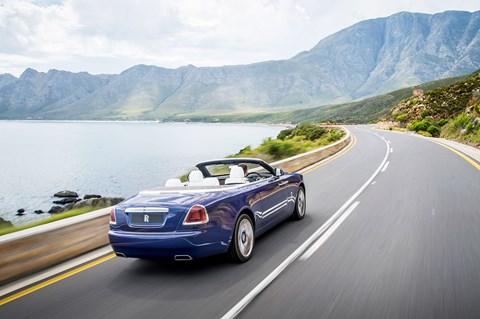
Rolls-Royce Dawn specifications
- Price £264,000
- Engine 6592cc twin-turbo V12, 563bhp @ 5250rpm, 575lb ft @ 1500rpm
- Transmission Eight-speed automatic, rear-wheel drive
- Suspension Multi-link with air springs front and rear
- Performance 4.9sec 0-62mph, 155mph (limited), 19.9mpg, 330g/km CO2
- Weight/made from 2560kg/steel
- Length/width/height 5285/1947/1502mm
- On sale Now
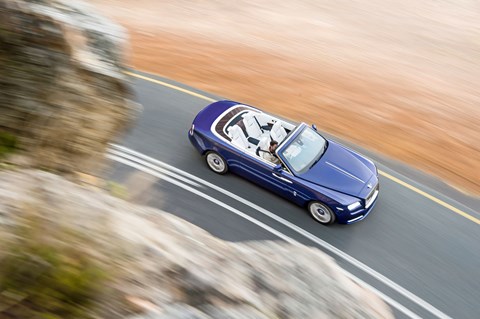
Breaking Dawn… down into 7 interesting factoids
Why Dawn?
‘Dawn is the world coming to light from the ethereal dark of the night,’ says Rolls Boss Torsten Müller-Ötvös. ‘The chill of dawn provides an erotic tingle on the skin.’ Well, quite
No noise ’n’ the hood
Six-layer fabric hood has French seams for lower wind noise. Despite vast size and weight it operates almost silently in 20sec at up to 30mph. It’s designed to produce a smooth profile with no concave sections or visible rails
Ghost-like power
Twin-turbo V12 makes the same power as a Ghost (563bhp), not a Wraith (623bhp). ‘Black Badge’ hasn’t been confirmed for Dawn, but expect it to happen, and expect a power uplift, as with Ghost, to match tauter chassis
Satellite box
Satellite Aided Transmission, which made its global debut on the Wraith in 2013, knows what’s ahead and alters the shift strategy of the ZF 8-speed. Other than pressing the ‘low’ button to lock out the upper ratios on a climb, the driver has no such control
Silence anyway
No stop/start system on Rolls-Royces. They don’t feel it’s appropriate, and you can’t hear the engine anyway. Interesting that the combined mpg figure is 19.9: any other carmaker would have massaged it up to start with a two
Flat calm
Despite a gross vehicle weight of around three tonnes, the runflat tyres will travel 100 miles at 50mph, enough to get you to a Kwik-Fit. This requires a hefty sidewall, but Rolls has optimised the tyres to eliminate choppy ride associated with runflats
A view of the lady
Front end has been made more upright than the Wraith’s: partly so that rear-seat occupants can see the (optionally uplit) Spirit of Ecstasy. Will be applied to Wraith when facelifted: the differences between the siblings will then be less marked
Read more CAR magazine features
